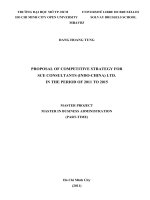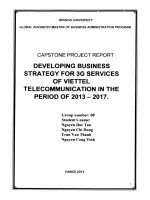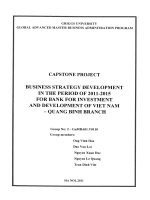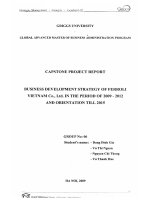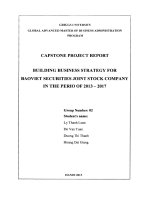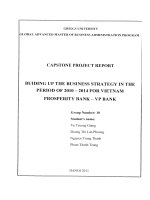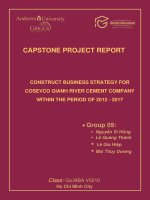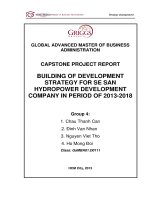business strategy for bach viet food industries ltd in the period of 2014 2018
Bạn đang xem bản rút gọn của tài liệu. Xem và tải ngay bản đầy đủ của tài liệu tại đây (2.15 MB, 99 trang )
Capstone project report.GaMBA01.C0112.Group 4
Global Advanced Master of Business Administration
BUSINESS STRATEGY FOR BACH VIET FOOD
INDUSTRIES LTD. IN THE PERIOD OF 2014 – 2018
Class Ga.MBA01.C0112 – Group 4
PHAM THI THU MINH
HA THI TU CHI
DOAN AI VY
TRAN VAN TIEN
Ho Chi Minh City, October 830, 2013
Capstone project report.GaMBA01.C0112.Group 4
ADKNOWLEDGEMENTS
Our team of the Group 4, the writers of this thesis, commit that this thesis of
"Building Business Strategy for Bach Viet Food Industries Ltd. in the period
of 2014-2018" is our serious study. The data and figures used in this writing are
honest, objective and suitable for the business practices. We also get the permission
and official confirmation of the Business Owner in the use of those data and figures.
Taking the advantages of this opportunity, we sincerely thank the Council members
of MBA Assessment program for your guidelines, comments and supports in the
implementation of the thesis. We also thank Bach Viet Food Industries’ Ltd. leaders
and management board for giving us favorable conditions and data supply for our
thesis completion. Another thank for Griggs University – America, Employment
and Training Center - Ha Noi National University, lecturers in the program and
classmates in the Ga.MBA01.C0112 for discussion, research, criticism on practices
and theories during the course. Special thanks for specialized consultants in honey
production, friends, families of group members for continuous supports to finish
this thesis.
Once again, sincerely thanks for all.
Ho Chi Minh City, September, 2013
Group 04 – Class GaMBA01.C0112
Page i
Capstone project report.GaMBA01.C0112.Group 4
TABLE OF CONTENT
ACKNOWLEDGEMENT .......................................................................................... i
TABLE OF CONTENT ............................................................................................. ii
LIST OF MODEL – TABULATION ....................................................................... v
INTRODUCTION ...................................................................................................... 1
1. Purpose of statement: ............................................................................................................ 1
2. Scope of research: .................................................................................................................. 2
3. Goal and objective of research: .......................................................................................... 3
4. Research methodology: ........................................................................................................ 3
5. Research meaning: ................................................................................................................. 4
6. Research outline: .................................................................................................................... 4
CHAPTER 1.FUNDAMENTAL THEORY OF BUSINESS STRATEGY .......... 5
1.1. Over view about business strategy ................................................................................. 5
1.1.1. Definition of business strategy .................................................................... 5
1.1.2. Roles of business strategy ........................................................................... 6
1.1.3. Important note in business strategy administration ..................................... 7
1.2. To build a business strategy ............................................................................................. 7
1.2.1. Business environment analysis .................................................................... 7
1.2.2. Internal Analysis........................................................................................ 11
1.2.3. Analysis and selection of business strategy .............................................. 13
CHAPTER 2.CURRENT STATUS OF BUSINESS OPERATION OF BACH
VIET FOOD INDUSTRIES LTD. .......................................................................... 21
2.1 About the company: .......................................................................................................... 21
2.1.1 Overview: ................................................................................................... 21
2.1.2 Establishment and development: ................................................................ 22
2.1.3 Organizational Structure: ........................................................................... 23
2.1.4 Introduction about honey production and consumption situation of the
company: ............................................................................................................. 24
2.1.5 Clients and Partners .................................................................................... 26
Page ii
Capstone project report.GaMBA01.C0112.Group 4
2.1.6. Business performance in the recent years ................................................. 27
2.2 Impact factors from external environment .................................................................. 25
2.2.1 Analys macro factors effecting to company operation .............................. 25
2.2.2 Honey bee production environment analysis ............................................. 29
2.2.3 Main domestic competititors analysis ........................................................ 33
2.2.4 Main foreign competitors analysis ............................................................. 38
2.3 Internal environment analys .......................................................................................... 41
2.3.1. Operation and management ....................................................................... 42
2.3.2 Employee, product, product quality ........................................................... 42
2.3.3 Product process, equipment, technology of factory ................................... 44
2.3.4 Marketing and customer relationship management: .................................. 45
2.3.5. Accounting and finance ............................................................................. 46
2.3.6. Information system and risk management ................................................ 52
2.3.7 Core competitive advantages...................................................................... 53
2.3.8 Internal Factor Evaluation matrix .............................................................. 54
2.4 Honey market and the company capability ................................................... 55
CHAPTER 3.BUSINESS STRATEGY FOR BACH VIET FOOD
INDUSTRIES LTD. IN THE PERIOD OF 2014 – 2018 ...................................... 60
3.1. Development orientation of honey production ......................................................... 60
3.1.1 Bee honey business global market: ............................................................ 60
3.1.2 Bee honey business in Viet Nam................................................................ 61
3.2. Company goal in 2014 – 2018 ...................................................................................... 62
3.2.1. Mission and vision: ................................................................................... 62
3.2.2. Annual business plan: ................................................................................ 62
3.2.3. Branding Bach Viet to 2018 ...................................................................... 60
3.3 Matrix for strategy evaluation and selection ............................................................ 60
3.3.1 SWOT Matrix: ............................................................................................ 61
3.3.2Matrix of Business Strategy Positioning (SPACE): .................................... 62
3.3.3 Preliminary Selection of Strategic .............................................................. 67
Page iii
Capstone project report.GaMBA01.C0112.Group 4
3.3.4 Quantitative Strategic Planning Matrix (QSPM) ....................................... 68
3.3.5. Select business strategy: ............................................................................ 72
3.4 Organization, solutions to apply strategies ................................................................. 74
3.4.1 Market penetration strategy ........................................................................ 70
3.4.2 Market Development Strategy: .................................................................. 78
3.4.3 Horizontal integration strategy: .................................................................. 82
RECOMMENDATIONS – CONCLUSION .......................................................... 79
REFERENCES ........................................................................................................... a
2. OPINION’ EXPERTS SURVEY FORM ............................................................ c
Page iv
Capstone project report.GaMBA01.C0112.Group 4
LIST OF MODEL – TABULATION
Chart 1.1. The interaction among levels of environment ............................................ 8
Chart 1.2. The 5 competitive forces model ................................................................. 9
Chart 1.3: Effects of micro environment and industrial environment on honey
producing and trading ............................................................................................... 11
Chart 1.4: SWOT Matrix........................................................................................... 17
Chart 1.5: The SPACE matrix ................................................................................... 18
Chart 1.6: Q.S.P.M matrix ........................................................................................ 19
Picture 2.7: The Company’s logo.............................................................................. 21
Chart 2.8: Organizational Structure Management .................................................... 23
Chart 2.9: External Factor Evaluation Matrix ........................................................... 35
Chart 2.10: Competitive profile matrix – domestic companies ................................ 39
Chart 2.11: Competitor profile matrix – foreign companies ..................................... 42
Chart 2.12: General process of produced honey ....................................................... 47
Chart 2.13: Process of impurities filter and separation ............................................. 47
Table 2.14: Yearly total assets of the company ........................................................ 50
Table 2.15: Yearly general capital of the company .................................................. 51
Table 2.16: Yearly business result of the company .................................................. 51
Table 2.17: Yearly cash flow of the company .......................................................... 53
Table 2.18: Financial indicator through years .......................................................... 54
Table 2.19: Internal Factor Evaluation Matrix.......................................................... 57
Table 3.20: SWOT matrix ......................................................................................... 65
Table 3.21: SPACE Matrix of Bach Viet Company ................................................. 67
Table 3.22: QSPM Matrix of 1st strategy group ........................................................ 70
Table 3.23: QSPM Matrix of 2nd strategy group ....................................................... 72
CONCLUSIONS - SOLUTIONS: Table: priorities in the selected strategies
Page v
Capstone project report.GaMBA01.C0112.Group 4
INTRODUCTION
1. Purpose of statement
Honeybee growth, the production and process of honey and honeybee's products are
one of high-valued economic sectors in Vietnam where is still an agricultural
country. The very large labor force in this sector, the favorable natural conditions
for production and the big domestic and foreign consuming markets make it a
potential economy for the high incomes contributing to the GDP. Especially, in the
difficult stages of 1990s and recent years, honeybee growth and production have
still been developing. Additionally, the production freedom and market
opportunities help Vietnam become one of the ten large export countries in the
world on honey and honeybee's products.
However, the economic value of this sector is still low mainly because of the export
and sale of new materials through the raw process to other productions or the low
quality of products which fails in creating added values from the production to
consumption. The development of food process industries is still low and the
advantages of inputs cannot be used as well as there are no effective business
strategies. Hence, how to use the inputs of honeybee production in cheap prices to
produce unique, high quality products aiming at adding values, developing and
competing in the market mechanism... is an important problem for the economy in
general and the seekers of business opportunities in particular.
As the economy develops, physical and mental demands increase, consumers'
attitudes with traditional useful products such as honey and honeybee's products are
expressed significantly. The Vietnamese widely integrated economy brings a lot of
opportunities for vietnamese enterprises in exporting products but big challenges
also. The clearest one is that the business globalization in the economy of
liberalization becomes more diversified and complicated. Moreover, since 2014, as
WTO's regulations, Vietnam has to widen the policies for the foreign invested
Page 1
Capstone project report.GaMBA01.C0112.Group 4
companies, with strength on capitals and technologies to be liberalized in the
investment of many fields, strictly increasing the pressure of competition.
For the sustainable competition and development in the market, Vietnamese
enterprises are required to make continuous efforts in product quality improvement,
cost and price reduction, more effective promotion and marketing... especially, the
most important thing is to identify and choose for the company a right "Business
strategy" which is suitable for the capacity, market and strategic vision in the long
term. This Business Strategy must be built on the basis of real market analysis in a
sufficient and scientific way, which recognizes company's strength and weakness as
well as matches the macro-economy environment, development direction of the
sector in the economy and other geographical and social aspects...moreover, taking
the opportunities and minimizing possible risks are required.
From the above requirements in real and knowledge on Business Administration in
MBA program, Griggs University (America), our group with 04 members including
02 members of family relationship with the selected company for the research
therefore having certain understanding on the company and its products, and 02
members working in the Commercial Bank and Real Estate has made decision to
choose the topic of "Building Business Strategies for Bach Viet Food Industries
Ltd. in the period of 2014-2018" as our final capstone project report in this course.
2. Scope of research
Research objects: Issues related to planning the Business strategy (Building the
strategy, planning, sorting out the solutions for the strategy implementation), in
which, the thesis provides an analysis of theoretical basis in line with operational
realities of the sector, market and enterprise, then delivers a specific business
strategy for Bach Viet Food Technologies Industries Ltd. in the period of 20142018.
Research scope: Bach Viet Industries has been currently producing one kind of
product which is processed honeybee food including honey and some other
Page 2
Capstone project report.GaMBA01.C0112.Group 4
honeybee products. Therefore its business guarantees as a SBU (Strategic
Business Unit). This thesis focuses Bach Viet's activities in domestic market and
exports to some countries such as USA, Japan, EU. The process of analysis and
strategy building include the comparison and checking with the big rivals in the
Honeybee Production sector of the market.
3. Goal and objective of research
- The research targets of this thesis are to focus steps of strategy building process,
to systematize theoretical knowledge on planning business strategies, then to use
as a basis for preparing the business strategy for the company to research
appropriately. This thesis will focus on the basic studying issues as follows:
Theoretical basis on business strategy, management of business management
in operation of some enterprises. Basic procedure for building and
management of business strategy.
Assessment on internal and external environment, current business situations
of
Bach
Viet
Industries,
withdrawing
shortcomings
and
strengths,
opportunities and challenges effecting company business activities in the past
years and 3 recent years.
- Throughout targets of this research are to build an effective business strategy for
Bach Viet Food Technologies Industries, including possible solutions and
recommendations to the company for the successful application of the business
strategy in the period of 2014-2018.
4. Research methodology
In our research process, we have used some basic studying methods as follows:
- Data collection method: Using general and detailed figures provided by Bach
Viet; Referring in materials, magazines, websites on Honeybee sector and
statistic figures. Collect information through the interview method with the
Enterprise owner, managers, workers, suppliers, consumers, distributors and
Page 3
Capstone project report.GaMBA01.C0112.Group 4
consulting methods with some individuals and colleagues who are keen on
honeybee production and business.
- Data solving method: Using the method of modeling, causal analysis, and
descriptive statistics in analysis of business activities' results incorporated the
method of administration subjects.
- Method of quantitive analysis based on data results, survey and collection data
and the use of statistical tools for analysis
- Expert method via communication and discussion with specialized experts for
assessment and comments to the research.
- General analysis method based on matrix tools and popular strategic analysis
models such as CPM, EFE, IFE, SWOT, SPACE, QSPM.
5. Research meaning
With the company's internal existing conditions and market potentials, this research
does not help Bach Viet Industries to plan its own business strategy only but
overcome its shortcomings, promote the business opportunities for the competition
and penetration to the old markets, development of the new one aiming at gaining
growth and profits.
6. Research outline
Beside introduction, suggestions, solutions, reference…, the thesis including 3
chapters as below:
Chapter 1: Fundamental theory of business strategy
Chapter 2: Current status os business operation of Bach Viet food industries
ltd.
Chapter 3: Business strategy for Bach Viet food industries ltd. in the period
of 2014-2018
Page 4
Capstone project report.GaMBA01.C0112.Group 4
CHAPTER 1
FUNDAMENTAL THEORY OF BUSINESS STRATEGY
1.1. Over view about business strategy
1.1.1. Definition of business strategy
There are many definitions about business strategy which consider it as art
to compete in the market and to develop the business:
- Strategy is maquette of targets and plans to get the targets (Kenneth, 1965);
- Quinn (1980): Strategy is pattern or plan to integrate main targets, policies
and chain of action into one unit with close structure;
- Strategy and making a unique, valuable position is inclusive of making the
difference, bringing more choices to concentrate the power to create the
advantage of the company (Michael Porter).
From angles of administration, strategy is a kind of plan.:
- G. Arlleret wrote "Strategy is determining the way and mean to get the target
through policies";
- D. Bizrell and partners wrote "Strategy is a general plan which leads the
company to desired targets. It is a base for making the policies and method of
operation";
- Gluecl wrote: "Strategy is a kind of united and all-sided plan which is
designed to guarantee that all of the targets will be realized”.
From angles of unity:
- “Strategy is an art of co-ordinate and control the activities to get the long-term
target of the company”;
- According to Chandler, strategy is including setting basic, long-term targets of
the company and choosing the way to dispose the power to realize the targets.
From the angles above, we can see that the difference between business strategy
and business plan is competitive advantages by taking use of core ability of the
company. From the reality we can see that every company must have business
Page 5
Capstone project report.GaMBA01.C0112.Group 4
strategy because a penetrative business strategy will guarantee the advantage of the
company in comparison with others in the market.
1.1.2 Roles of business strategy
- Business strategy helps the company determine its targets which is a base for all
of the activities of the company.
- Business strategy help the company catch and take use of all chance in the
market as well as bringing method to overcome risks in the competitive market.
- Business strategy helps the company to use the man power more effectively
which will bring stable development of the company.
- Business strategy creating stable foundation for providing policies and decision
which is suitable to changes of the market.
Therefore, business strategy takes an important part in the success or lost in
business of a company.
1.1.3. Important notes in business strategy administration
Advantages:
- The process of administrating strategy help the company see clearly the target
and its direction, base on which, administrators can consider and determine the
way to reach targets.
- The condition of business environment is changeable. The fast changes always
create chance and sudden. Strategy administration helps administrator foresee
and take use of chance and challenge. The processes of strategy administration
make administrators analyze and forecast the condition in far future which will
help them catch and take use of chance, minimize the risk in term of
environment.
- Thanks to strategy administration, a company will link decisions with
environmental condition which will make them more active in all decisions. The
companies that don't use strategy administration often make decision passively.
The decision, sometimes, brings good result, however, it doesn't help the
companies to catch up with the change of environment and control it.
Page 6
Capstone project report.GaMBA01.C0112.Group 4
- Many researches show that the company that has strategy administration will
have better result. However, this doesn't mean that the company using strategy
administration won't meet the difficulty. The key is that it will help to minimize
the risk when they meet difficulty.
Disadvantages:
- It takes a lot of time and effort to build the strategy and administration.
However, once the company experienced the process of strategy administration
it will save a lot of time.
- Action plans somehow will be considered as being created inflexibly in written
without timely adjustment.
- The shortcomings in forecasting sometimes will be made
- Some administrators doubt on the use and feasibility of strategy administration.
However, the problem is not at the strategy administration but at the person who
use it. Obviously, companies must implement the entire plan, not just give out
the plan and let it be.
1.2. To build a business strategy
1.2.1. Business environment analysis
Analyzing the business environment is a process that strategy-makers check all of
environmental elements. The purpose of environmental analyzing and judgment is
determined chances and risks. Analyzing macroscopic and microcosmic
environment - also called as "branch environment". There are many levels of
analyzing business environment. The interaction among levels of environment is
illustrated in the chart 1.1.
Page 7
Capstone project report.GaMBA01.C0112.Group 4
Chart 1.1. The interaction among levels of environment
1.2.1.1. Macro environment analysis
a. Environment of Government, Law and Politics
Government, law and politics act on business in different angles. They can creat
opportunities or obstacles, even risks for business such as: the stable of politics,
changes of policy, decisions of tax and fee, labour law, union…
b. Environment of economics:
Economics status and trend impact on the success and business strategy of
enterprise. Key elements that many companies analyse are the growth speed of
economics, rate, exchange rate and inflation rate…
c. Environment of culture and sociaty
In the medium and long term, this may be the biggest changed element. Enterprise
must consider some factors as the come of new life style, consumer behavior,
change of population age, marital rate and born, immigration…
d. Environment of technology:
Page 8
Capstone project report.GaMBA01.C0112.Group 4
The change of technology obviously effects to the life cycle of product or service.
Moreover, this will effect on product methodology, material as well as labour
behavior. Hence, administrator is requested to concern on change and invests for
technology and product improvement.
e. Environment of nature
Wise strategist usually pays attention to climatic and ecological environment.
Trends of natural environment as the rapid exhaustion of the natural resources,
pollution increased, global changes in climate, food safe… create dangers to some
business but also opportunities for some others. This required strategist always
considers every matter carefully.
f. Environment of globalization
Globalization is an obvious trend that all enterprises, fields and governments must
be awared of. Strategists now call “the big house”. In this scenario, international
environment is a special case of general external environment of enterprises.
However, it would be more complicated, compete differently because of different
views about society, culture, structure, policy and economy…
1.2.1.2. Industrial environment analysis
Strategists have to analyze and predict competitors in the industry to define
opportunities and threats of business.
M. Porter created the 5 forces analyze that can help:
Chart 1.2. The 5 competitive forces model
Page 9
Capstone project report.GaMBA01.C0112.Group 4
a. Current competitors analyze
The first force in this model is the size of a product field, including: competitive
structure, demand situation and output barrier.
b. Potential competition analyze
The second force is potential competitors, they are enterprises that currently not
compete in the same industry but they have ability if they choose to enter the
industry. The advantage and disadvantage level for the industry entrance depend
mostly on the entrance barrier.
c. Supplier pressure analyze
The third force is the ability to bargain of suppliers. In some aspects, threats from
suppiers create dependence to enterprises
d. Client pressure analyze
This force creates “bargain capacity” for buyers. Buyes are the end users,
distributors (whole sale or retail) and buy product to use as input for production
e. Threat from substitute products analyze
The last force in M.Portet model is threats from substitute products – another
product that can meet the demand of customers – which basic feature has some
outstanding advantages than the current product. Threats from this require
enterprises to analyze and keep an eye on technical changes or improvements and
renew products. Changes from the need of market are also a key factor caused these
threats
Page 10
Capstone project report.GaMBA01.C0112.Group 4
Chart 1.3: Effects of micro environment and industrial environment on honey
producing and trading
1.2.2. Internal Analysis
The objective of internal analysis and evaluation is to study what belongs business
itself, has a direct or indirect impact to business activities, which are the strengths
and weaknesses of the business. It was created with the purpose of creating basis
information for strategic planning in business management strategy, but objects we
consider in this analysis is about control of business, different from external
environment. Hence, pointed out strengths and weaknesses of each side, each field
as a basis for formulating business strategies.
Internal analysis conducted by different approaches. One common approach is to
analyze the internal enterprise in the field of corporate governance.
1.2.2.1. Evaluation of Marketing
The term marketing refers to the processes, functions, exchange and activities
geared towards creating value by meeting the needs of the market. Marketing brings
customers closer to busines, products to make a purchase decision and create
favorable conditions for the sales activities of the business.
1.2.2.2. Evaluation of financial – accounting
a. Analysis of general financial status through Financial Statements
Page 11
Capstone project report.GaMBA01.C0112.Group 4
Analysis of the financial statements is related to using information to have full
understanding about the company. The financial statements can be regarded as a
vivid picture and clarity on the financial situation of the company.
- Consolidated Balance Sheet is financial statements reflects the assets and
liability of the business a time in the business process.
- The operating result is a summary of the income of the business during the
accounting period (usually a year), it indicates the profit allocated to
stakeholders of the business now such as the creditor, state, preference
shareholders, our shareholders and all other resources.
- Cash flow statements reflecta the impact of business activities to cash flow in
and out of an accounting period. In other words, it is reported revenues in a fund
accounting period, it says the cash position of the business represented by the
amount of money raised and used in the operation of the business, from which
said Ending cash balance.
b. Financial Analysis through Financial Indicators
The financial statements together indicate general financial position of the business
from time to time or in a period of activity. However, in order to better understand
the financial performance and appreciate the power and value of the business, it is
necessary to conduct analysis of financial indicators. Financial indicators were
designed to quantitatively evaluate all the different aspects of the financial
operations of the business.
The goal of financial management is to gether with the different functional activities
strive to maximize the value of business. So, the first question that the analysis
should answer is whether the business profitable or not and how level? Profitability
is the end result of a series of policy and decisions proposed and implemented by
managers. These indicators evaluate the coordination of assets and capital
management activities of company.
Page 12
Capstone project report.GaMBA01.C0112.Group 4
1.2.2.3. Evaluation of corporate management and governance
Corporate management and governance is the process of planning, designing,
operating and monitoring the organization and supervision of the production system
in order to implement the business objectives. The task of governance is to design
and organize business systems that transform inputs into output elements after each
variable progress.
1.2.2.4. Assessment of human resources management
Human Resource Management is a system of philosophy, policy and operational
functions in attracting, training - development and maintenance labour for
organization to achieve optimal results for both the organization and the member.
We can divide the major activities of the human resource management function into
three major groups as follows:
- Attract human resources. This group functions focus to ensure a sufficient
number of qualified staff that meet the business requirements.
- Training and development. This group functions focus on building capability for
staff, ensuring that they are qualified and have necessary skills to complete
assigned tasks and support staff to maximize invidual abilities
- Maintenance human resources: This group functions focus on maintenance and
effectively use of human resources in the enterprise. Group functions includes
two smaller functions that are stimulate, motivate employees and to maintain and
develop good working relationships in the beauty business.
1.2.3. Analysis and selection of business strategy
1.2.3.1. Technical analysis-oriented business strategy
a. Competitive Profile Matrix (CPM)
Competitive Profile Matrix (CPM) to compare company and competitors, mainly
based on the factors affecting the competitiveness of enterprises in the industry,
thereby helping managers recognize strengths and weaknesses of the business as
well as competitors in order to determine a competitive advantage for enterprises
Page 13
Capstone project report.GaMBA01.C0112.Group 4
and weaknesses that need to be addressed. There are 5 steps to follow to build CPM
as below:
o Step 1: Make a list of 10 factors that critically influence to the competitiveness
of firms in the industry.
o Step 2: Sort the importance (propotion) from 0.0 (not important) to 1.0 (very
important) to each factor. This classification shows the relative importance of
each factor depends on the level of the factors affecting the competitiveness of
enterprises in the industry, but the total importance of all these factors must
equal to 1.0.
o Step 3: Determine the evaluation, ranking from 1 to 4 for each factor, the
ranking of each factor depends on the ability of businesses to respond to the
elements, in which 4 is good, 3 is above average, 2 is average and 1 is weak.
o Step 4: Multiply the importance of each factor with its assess and rating to
determine the score of factors.
o Step 5: Plus score of all the factors to determine the total score of matrices.
Compare the total score of enterprises with major competitors in the industry to
evaluate the competitiveness of enterprises selected from rivals.
b. External Factor Evaluation Matrix (EFE)
External Factor Evaluation Matrix (EFE) allows strategists summarize and evaluate
the impact of the information economy, society, culture, demography, geography,
politics, government, law, technology and competition. There are five steps to
developing an evaluation matrix of external factors:
o Step 1: Make a list of elements from 10 to 20 opportunity and risk mainly play
decisive roles for the business success that being identified through the research
of external information.
o Step 2: Sort out the importance (propotion) from 0.0 (not important) to 1.0 (very
important) to each factor. This classification shows the relative importance of the
factors to the business success, but the total importance of all the factors must
equal to 1.0.
Page 14
Capstone project report.GaMBA01.C0112.Group 4
o Step 3: grade for of determinant of success, rank from 1 to 4 for the possibility
that the current strategy of the business may response, which 4 is good response,
3 is above average response, 2 is average response and 1 is weak response
o Step 4: Multiply the importance of each factor for its classification to determine
score of importance for each factor
o Step 5: Plus all points of elements to have the total score of matrix. If total score
is below 2.5 points then the company is weak at internal resources, if the score is
above 2.5 then the company has strong internal resources.
c. Internal Factor Evaluation Matrix (IFE)
This tool is used to summarize and evaluate the strengths and weaknesses of the
important business function in the company it also provides a basis information to
identify and assess the relationship between these functional units. IFE Matrix can
be developed in five steps:
o Step 1: Make a list of element from 10 to 20 in order, starts from the strengths to
weaknesses of the internal forces that affecting to business development.
o Step 2: Set the importance 0.0 (not important) to 1.0 (very important) to each
factor. The importance assigned to each factor given that the relative importance
of that factor to the success of businesses in the industry. Excluding major is the
strength or weakness, all factors that have greatest impact on the performance of
the business must be consider as the most important. But the total score must be
1.0.
o Step 3: grade 3 or 4 for each key factor impact directly to the success, 1 to 2
points for each weakness factor. This classification shows how the current
strategy of the business response to these factors. In which 4, 2 is good and 3, 1
is weak and not good at reaction.
o Step 4: Multiply the importance (porpotion) of each factor with its classification
to determine the grade of each factor’s importance.
o Step 5: Add up all elements’ point to determine the critical point of the matrix. If
the total score exceeds 2.5 competitiveness of enterprises is above average
Page 15
Capstone project report.GaMBA01.C0112.Group 4
strength and vice versa if the total scores below 2.5, the competitiveness is below
average.
1.2.3.2. Business strategy choice
a. SWOT Matrix
This is a tool for analysis, formulation and strategic choice, the revised strategy,
review and evaluates the position and orientation of a business or a business plan.
SWOT analysis can be used for all kinds of decisions and SWOT template enables
thinking positively, beyound the habit or instinct.
SWOT matrix is used to list all the opportunities, threats, strengths and weaknesses
within the enterprise, in order and proper position. Based on the relationship
between these factors, the analysis will be conducted to select appropriate solutions
through strategic combinations: strengths-opportunities (SO), strengths-risk (ST)
and weaknesses-risk (WT) and weaknesses-opportunities (WO). This method is
very simple, easy to apply and can be used in many areas of business activity.
SWOT presents 4 basic strategy groups.
SO: The constitution is based on the strategy of the business strengths to exploit
outside opportunities.
ST: The strategy is based on the strengths of the business in order to prevent or limit
the risk from outside.
WO: The weakness of this strategy reduced internally to take advantage of external
opportunities.
WT: The weakness of this strategy reduced internally to prevent or limit the
external risk.
The experienced administrators never consider all feasible strategies beneficial to
the company because there are many possible solutions and ways to implement
these strategies. Therefore, only a set of the most attractive strategic options is used
for development. There are 8 steps to make a SWOT matrix:
1) List the opportunities outside the company.
2) List the critical threat outside the company.
Page 16
Capstone project report.GaMBA01.C0112.Group 4
3) List the major strengths of the company.
4) List the weaknesses within the company.
5) Combine the strengths of the external opportunities, the result of SO strategy
in the appropriate box.
6) Combine internal weaknesses with external opportunities, making strategic
WO result in the appropriate box.
7) Combine the strengths of the external threat, the result of appropriate
strategies in ST.
8) Combine internal weaknesses with external risk; put the result of WT
strategies appropriate box.
SWOT
Opportunities (O)
1...
2...
Threats (T)
1...
2...
Strengths (S)
Strategy S-O
Strategy S-T
1...
2…
Strategic use of corporate Strategic use of corporate
strengths to take advantage of strength to cope, to avoid
external opportunities.
external threats.
Weakness (W)
Strategy W-O
1...
Strategies
to
overcome Strategies
to
overcome
weaknesses of the business to weaknesses of the business to
take advantage of external reduce external threats.
opportunities
2...
Strategy W-T
Chart 1.4: SWOT Matrix
b. SPACE Matrix
This is the defining tool, help businesses define business strategy. SPACE Matrix
for information analyzed in the period, including two within factors: financial
strength (FS) and competitive advantage (CA), two external factors: environmental
stability (ES) and the strength of the sector (IS). The matrix includes 6 steps:
-
Step 1: Select a set of variables representing FS, CA, ES and IS.
-
Step 2: Assign values from 1 (worst) to 6 (best) for FS and IS, from -1 (best)
to -6 (worst) to ES and CA.
Page 17
Capstone project report.GaMBA01.C0112.Group 4
-
Step 3: Calculate the average score for FS, IS, ES and CA
-
Step 4: Check the average score for each aspect.
-
Step 5: Plus 2 points on the horizontal axis and mark results, plus two points
on the vertical axis and check the results. Mark the coordinates of the new
point.
-
Step 6: Draw the vector directed from the origin to the new location, the
direction vector of the box from which is to locate the appropriate group
strategy of the business.
Cautious strategy
CA
FS
6
5
4
3
2
1
Attack Strategy
-6 -5 -4 -3 -2 -1
0 1 2 3 4 5 6
-1
-2
Defense strategy
-3
-4
Competitive Strategy
-5
-6
ES
Chart 1.5: The SPACE matrix
IS
1.2.3.3. Quantitative Strategic Planning Matrix (QSPM)
QSPM is a tool used to quantify the information has been analyzed in the first phase
which allows administrators to select the optimal strategy; QSPM matrix includes 6
basic steps:
Step 1: List opportunities and threats from the outside and big weaknesses,
significant strengths within the enterprise.
Page 18
Capstone project report.GaMBA01.C0112.Group 4
Step 2: Classify (weights) for each critical success factors inside and outside, the
same classification as the EFE Matrix, IFE Matrix. The total weight of the external
factors of 1.0 and the total weight for the internal factor is 1.0.
Step 3: Identify alternative strategies that can be considered to use from SWOT
matrix, SPACE.
Step 4: Determine the number of points for each strategy. Number of points denotes
the relative attractiveness of each strategy compared to other strategies, assessment
scale from 1 to 4 where 1 is not attractive, the attractive low 2, 3 is quite attractive ,
4 is very attractive.
Step 5: Calculate the total number of attractions, this is the result of the
classification score (step 2) the number of points (step 4) in each row. The higher
score of attractions higher the more attractive strategy.
Step 6: Plus number of attractions. It is the sum of total number of points in the
column of the QSPM strategy. The difference between the total number of and
points in a strategy group, the higher score indicates the more attractive strategy.
Strategy can replace
No
The important factor
Proportion Strategy 1
Strategy 2
Strategy (n)
AS TAS
AS TAS
AS TAS
The external factors
1
2
…
The internal factors
1
2
…
Total points
Chart 1.6: Q.S.P.M matrix
Page 19
